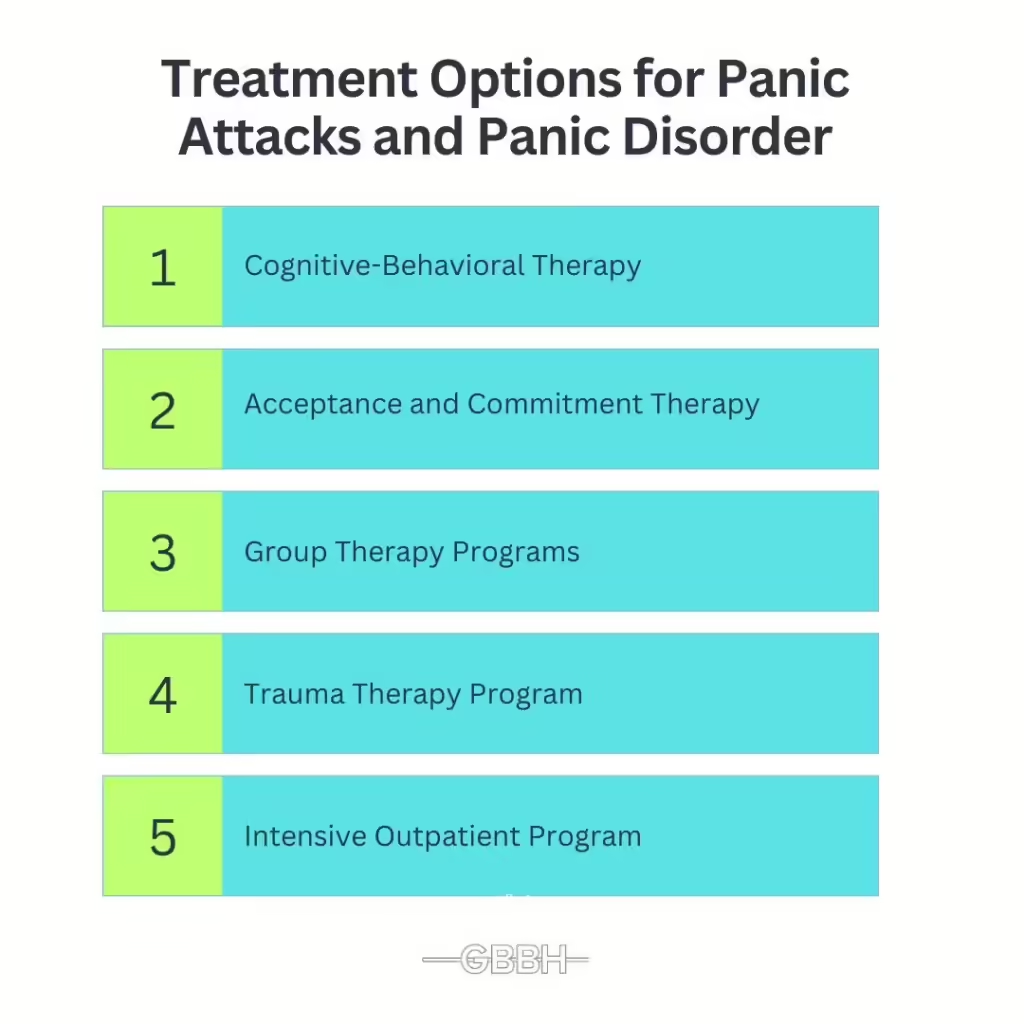Panic attacks and panic disorder are mental health conditions that can drastically affect an individual’s life. These episodes can be terrifying and often leave lasting emotional and physical effects. At Greater Boston Behavioral Health, we are committed to helping individuals understand and manage these challenges through our comprehensive Mental Health Programs.
What Are Panic Attacks?
A panic attack is an intense period of fear or discomfort that typically peaks within minutes. Individuals can experience panic attacks unexpectedly or in response to specific situations. During these episodes, the body goes into a state of high alert, activating the fight-or-flight response.
Common Symptoms of Panic Attacks
Panic attacks can manifest through a range of physical and emotional symptoms, which may include:
- Rapid Heartbeat:
- A pounding or racing heart can feel alarming, often leading individuals to fear they might be having a heart attack.
- Shortness of Breath:
- Many experience difficulty breathing, which can feel like choking, intensifying feelings of panic.
- Chest Pain:
- Chest discomfort or pain can occur, further escalating anxiety about health and well-being.
- Sweating:
- Excessive sweating, often paired with chills or hot flashes, can be a prominent symptom during an attack.
- Trembling or Shaking:
- Physical trembling may occur, which can contribute to feelings of helplessness.
- Dizziness or Lightheadedness:
- A sense of dizziness or feeling faint can lead to a heightened sense of danger.
- Nausea or Abdominal Distress:
- Many report gastrointestinal distress, including nausea or a sensation of a “knot” in the stomach.
- Fear of Losing Control or “Going Crazy”:
- This fear can exacerbate the distress experienced during a panic attack.
- Fear of Dying:
- An overwhelming fear of imminent death or disaster can accompany the other symptoms.
Understanding Panic Disorder
Panic disorder is diagnosed when a person experiences recurrent and unexpected panic attacks, coupled with ongoing concern about having more attacks or the implications of those attacks. This condition can significantly disrupt daily life, often leading to avoidance behaviors and social withdrawal.
The Impact of Panic Disorder on Daily Life
Living with panic disorder can limit one’s ability to engage in everyday activities. Here are some ways it can affect life:
- Avoidance Behavior:
- Individuals may start avoiding places where they fear an attack could occur, such as crowded areas, public transport, or even leaving home.
- Social Isolation:
- Fear of experiencing a panic attack in social situations may lead to withdrawal from family and friends, creating feelings of loneliness.
- Impact on Work and Daily Activities:
- The fear and anxiety associated with panic disorder can hinder performance at work and make everyday tasks overwhelming.
The Role of Comorbid Conditions
Many individuals with panic disorder also experience other mental health issues, such as generalized anxiety disorder, depression, or substance use disorders. This comorbidity can complicate the diagnosis and treatment process, making it crucial to address all underlying conditions in a comprehensive treatment plan.
Causes of Panic Attacks and Panic Disorder
The causes of panic attacks and panic disorder are multifaceted, involving a combination of genetic, biological, environmental, and psychological factors. Understanding these causes can help individuals gain insight into their experiences.
- Genetic Predisposition:
- A family history of anxiety disorders may increase the likelihood of developing panic disorder, suggesting a genetic component.
- Brain Chemistry:
- Imbalances in neurotransmitters, particularly serotonin and norepinephrine, can influence anxiety levels and panic responses.
- Environmental Stressors:
- Traumatic experiences, significant life changes, or chronic stress can serve as triggers for panic attacks. Events such as the death of a loved one, divorce, or job loss can heighten anxiety.
- Personality Factors:
- Individuals with certain personality traits, such as high sensitivity to stress, may be more prone to panic attacks. Those who have a history of anxiety or mood disorders are also at greater risk.
- Co-occurring Mental Health Conditions:
- Conditions such as generalized anxiety disorder, obsessive-compulsive disorder, or depression can increase vulnerability to panic disorder, making early intervention crucial.
Seeking Help: Treatment Options for Panic Attacks and Panic Disorder
If you or someone you know is struggling with panic attacks or panic disorder, seeking help is essential. Effective treatments are available, and at Greater Boston Behavioral Health, we offer a variety of Mental Health Treatment Programs tailored to individual needs.

Comprehensive Treatment Approaches
- Cognitive-Behavioral Therapy (CBT):
- Cognitive-Behavioral Therapy is an evidence-based approach that helps individuals identify and challenge negative thought patterns and behaviors. By understanding the relationship between thoughts, feelings, and actions, individuals can develop healthier coping mechanisms.
- Dialectical Behavior Therapy (DBT):
- Dialectical Behavior Therapy integrates cognitive-behavioral techniques with mindfulness practices. This therapy is particularly beneficial for those struggling with intense emotions and interpersonal relationships, promoting better emotional regulation.
- Acceptance and Commitment Therapy (ACT):
- ACT encourages individuals to accept their thoughts and feelings rather than trying to control or eliminate them. Acceptance and Commitment Therapy focuses on mindfulness and helps individuals commit to actions that align with their values, reducing the impact of panic attacks on their lives.
- Medication:
- In some cases, medication may be prescribed to manage symptoms. Selective serotonin reuptake inhibitors (SSRIs) and benzodiazepines are commonly used to alleviate anxiety and reduce the frequency of panic attacks.
- Group Therapy Programs:
- Group therapy program provides a supportive environment where individuals can share their experiences, learn from one another, and practice social skills in a safe setting. This community aspect can enhance feelings of connection and understanding.
- Trauma Therapy Program and EMDR Therapy:
- For those whose panic attacks are related to trauma, specialized trauma therapy, including Eye Movement Desensitization and Reprocessing (EMDR), can be effective in processing and healing from past experiences.
- Intensive Outpatient Program (IOP):
- For individuals needing more structured support, an Intensive Outpatient Program offers comprehensive treatment while allowing them to live at home. This program includes regular therapy sessions, skills training, and opportunities for personal growth.
Coping Strategies for Managing Panic Attacks
In addition to professional treatment, individuals can benefit from practical coping strategies to manage panic attacks:
- Mindfulness Practices:
- Engaging in mindfulness techniques, such as meditation or deep-breathing exercises, can help regulate emotions and reduce the intensity of panic attacks.
- Establishing a Support System:
- Building a strong support network of family and friends can provide encouragement and understanding during difficult times. Sharing experiences with others who have similar challenges can foster a sense of community.
- Journaling:
- Keeping a journal can help individuals track their feelings and experiences, providing insight into triggers and patterns that contribute to panic attacks.
- Regular Exercise:
- Physical activity is an effective way to reduce anxiety and improve mood. Incorporating regular exercise into daily routines can help mitigate the effects of stress.
Conclusion
Panic attacks and panic disorder can feel overwhelming, but help is available. If you or someone you know is struggling with these conditions, it’s essential to seek professional support. At Greater Boston Behavioral Health, our Mental Health Treatment Center in Massachusetts is dedicated to providing compassionate care and effective treatment options for individuals facing anxiety-related challenges. Through a combination of therapies and support, we aim to help you regain control of your life and overcome the obstacles posed by panic disorder. Call us at: (888)278-0716 today to get more info on our treatment and procedures.
FAQ: Panic Attacks and Panic Disorder
What is the difference between a panic attack and panic disorder?
A panic attack is an intense episode of fear or discomfort that typically lasts for a few minutes, while panic disorder is characterized by recurrent and unexpected panic attacks, along with persistent concerns about having more attacks or their consequences.
What are the common symptoms of a panic attack?
Common symptoms include rapid heartbeat, shortness of breath, chest pain, sweating, trembling, dizziness, nausea, feelings of losing control, and fear of dying.
What causes panic attacks and panic disorder?
Causes can include genetic predisposition, brain chemistry imbalances, environmental stressors, personality factors, and co-occurring mental health conditions.
How is panic disorder diagnosed?
Diagnosis typically involves a comprehensive assessment by a mental health professional, who will evaluate symptoms, medical history, and any potential underlying conditions.
What treatment options are available for panic disorder?
Treatment options include Cognitive-Behavioral Therapy (CBT), Dialectical Behavior Therapy (DBT), Acceptance and Commitment Therapy (ACT), medication, group therapy, and intensive outpatient programs.
Can I manage panic attacks on my own?
While professional treatment is important, individuals can also benefit from coping strategies such as mindfulness practices, journaling, exercise, and building a strong support system.
Are panic attacks dangerous?
While panic attacks are not physically dangerous, they can be very distressing and may lead to avoidance behaviors that impact daily life. It’s essential to seek help if you experience frequent panic attacks.
How long do panic attacks last?
Panic attacks typically peak within 10 minutes and can last anywhere from a few minutes to around 30 minutes, although some residual symptoms may persist.

